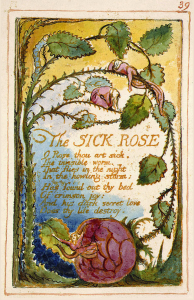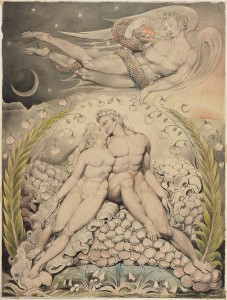Honestly, I never knew that William Blake had been a printmaker and a painter in addition to being a poet. I remember studying William Blake during my freshmen year of high school, but it we had examined his poems within a larger collection of British poetry, alongside the work of William Wordsworth, and other English poets. The collection did not include any prints or illustrations, so visuals to go along with the poems was left to the imagination. One poem my class studied extensively was “The Tyger.” I even remember my teacher having each person in my class read the poem out loud so we could have a personal interpretation of how the poem is read. I personally thought the poem was very dark, and had a heavy tone to it. The poem starts off with the lines “Tyger Tyger, burning bright,/ in the forests of the night;” and I imagined a tiger emerging from a dark forest, a beacon of light. The fourth stanza really establishes the rhythm for me, and it incorporates the heavy tone I associate with the poem.
“What the hammer? what the chain,/ In what furnace was thy brain?/ What the anvil? what dread grasp,/ Dare its deadly terrors clasp!”
From this stanza, I imagined a furnace, which is something that is usually surrounded by darkness, but within the furnace there are embers and fire that emit light. The imagery in my head was similar to the tiger being illuminated within the dark forest. Overall there was still a sense of darkness and power in the poem. The way I pictured the poem without illustrations in high school definitely influenced the way I perceive the poem today. I was surprised by the way William Blake printed “The Tyger” in Songs of Experience because it seemed too happy to me. It’s not the most colorful poem in the book, but the color scheme is made of pastels, giving it a lighter tone. The sky is kind of dark blue in one corner but it does not indicate the dark forest I had pictured five years ago. The tiger is the focus of the print, but it doesn’t pop out from the page because it is “burning bright.” Instead the tiger contrasts the pastels since it is drawn with such heavy lines. I imagine the page looks the way it does because of the way Blake printed, working with the positive instead of the negative. I’m just shocked at how differently I had picture the poem just based on the words from the way Blake chose to show it in the Songs of Experience. I wonder if anyone else in the class did not expect the Songs of Experience to be like this.


